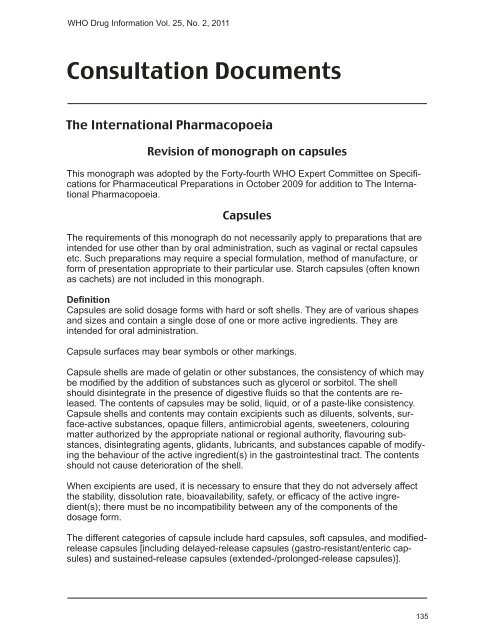WHO Drug Information Vol. 25, No. 2, 2011
WHO Drug Information Vol. 25, No. 2, 2011
WHO Drug Information Vol. 25, No. 2, 2011
You also want an ePaper? Increase the reach of your titles
YUMPU automatically turns print PDFs into web optimized ePapers that Google loves.
<strong>WHO</strong> <strong>Drug</strong> <strong>Information</strong> <strong>Vol</strong>. <strong>25</strong>, <strong>No</strong>. 2, <strong>2011</strong>Consultation DocumentsThe International PharmacopoeiaRevision of monograph on capsulesThis monograph was adopted by the Forty-fourth <strong>WHO</strong> Expert Committee on Specificationsfor Pharmaceutical Preparations in October 2009 for addition to The InternationalPharmacopoeia.CapsulesThe requirements of this monograph do not necessarily apply to preparations that areintended for use other than by oral administration, such as vaginal or rectal capsulesetc. Such preparations may require a special formulation, method of manufacture, orform of presentation appropriate to their particular use. Starch capsules (often knownas cachets) are not included in this monograph.DefinitionCapsules are solid dosage forms with hard or soft shells. They are of various shapesand sizes and contain a single dose of one or more active ingredients. They areintended for oral administration.Capsule surfaces may bear symbols or other markings.Capsule shells are made of gelatin or other substances, the consistency of which maybe modified by the addition of substances such as glycerol or sorbitol. The shellshould disintegrate in the presence of digestive fluids so that the contents are released.The contents of capsules may be solid, liquid, or of a paste-like consistency.Capsule shells and contents may contain excipients such as diluents, solvents, surface-activesubstances, opaque fillers, antimicrobial agents, sweeteners, colouringmatter authorized by the appropriate national or regional authority, flavouring substances,disintegrating agents, glidants, lubricants, and substances capable of modifyingthe behaviour of the active ingredient(s) in the gastrointestinal tract. The contentsshould not cause deterioration of the shell.When excipients are used, it is necessary to ensure that they do not adversely affectthe stability, dissolution rate, bioavailability, safety, or efficacy of the active ingredient(s);there must be no incompatibility between any of the components of thedosage form.The different categories of capsule include hard capsules, soft capsules, and modifiedreleasecapsules [including delayed-release capsules (gastro-resistant/enteric capsules)and sustained-release capsules (extended-/prolonged-release capsules)].135

















